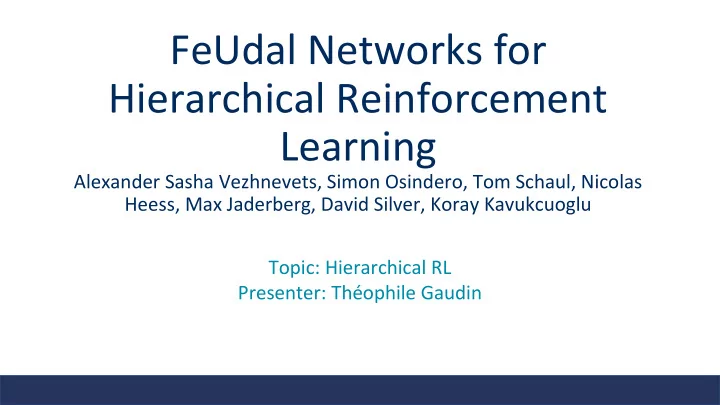

FeUdal Networks for Hierarchical Reinforcement Learning Alexander Sasha Vezhnevets, Simon Osindero, Tom Schaul, Nicolas Heess, Max Jaderberg, David Silver, Koray Kavukcuoglu Topic: Hierarchical RL Presenter: Théophile Gaudin
Why Hierarchical RL? • RL is hard • Sparse reward • Long time-horizon https://www.retrogames.cz/play_124-Atari2600.php?language=EN • More “human-like” approach to decision making
Human-like decision making When we type on a computer keyboard, we just thinking about the words we want to write . We don’t think about each our fingers and muscles individually. We make hierarchical abstractions Could this work for RL too?
Feudalism? Governance system in Europe between 9-15th centuries Top-down “management” https://en.wikipedia.org/wiki/Feudalism
Feudal Reinforcement Learning (Dayan & Hinton 93’) • Only top Manager sees the environment reward • Managers rewards and set goals for level below • Managers are not aware of what happens at other level
FeUdal Networks Manager • Lower temporal resolution • Sets directional goals • Rewarded by env. Worker • Higher temporal resolution • Rewarded by the Manager • Produces actions in env. No gradient are propagated between the Manager and the Worker
Directional vs Absolute Goals An absolute goal would be to reach a particular state Ex: you have an address to reach A direction goal would be to go towards a particular state Ex: you have a direction to follow
Model Architecture Details
How to train this model? • Could use TD-learning but then g t would not have any semantic meaning • Approximate transition policy gradient Manager Worker Direction in the latent space
Manager RNN: Dilated LSTM ● Memories over longer periods ● Outputs are summed over c steps ● Performs better “Standard” RNN Dilated RNN
Results on Atari games
Sub-policies inspection
Sub-policies inspection
Is the Dilated LSTM important?
Influence of 𝝱
Transfer Learning ● They changed the number of action repeat
Did it solve Montezuma’s Revenge?
Sum up of the results • Using directional goals works well • Better long-term credit assignment • Better transfer learning • Manager’s goals corresponds to different sub-policies • Dilated LSTM is essential for good performance • Meticulous ablation studies - proving their points with evidence (vs claiming SOTA)
FeUdal Network vs Options Framework ● Only one Worker vs many options ○ Memory efficient ○ Cheaper computationally ● Meaningful goals producing different sub-policies ● “Standard” MDP
Contributions (recap) • Differentiable model that implements Feudal RL • Approximate transition policy gradient for training the Manager • Directional goals instead of absolute • Dilated LSTM
Has this method inspired others? https://sites.google.com/stanford.edu/iris/ Learning Latent Plans from Play https://learning-from-play.github.io/
Open challenges • Montezuma’s revenge remains a challenge • Maybe using deeper hierarchy and different time scale? • Transfer learning from an environment to another?
Recommend
More recommend